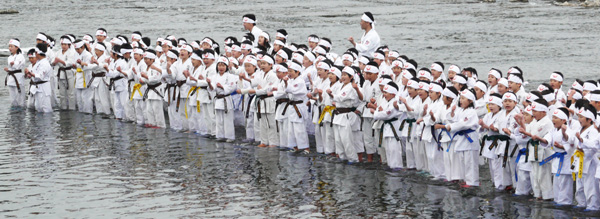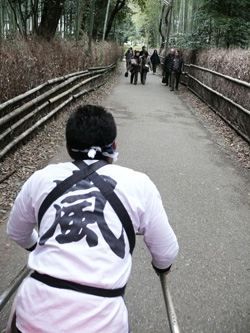KYOTO, JAPAN - The young rickshaw driver doesn't wince when the supersized Canadian approaches and asks to be taken for a ride in Japan's traditional two-wheel hand-pulled cab.
"I can pull over 300 kilograms without sweating," boasts the muscular Nori, who quickly steadies the awkward-looking mini carriage with the gleaming spoked wheels and helps the stranger and his petite partner aboard.
After wrapping us in a blanket to protect us from the bone-chilling cold on this wintry January day, Nori checks that the way is clear before pulling out onto the busy roadway for our rickshaw tour of Arashiyama, a lovely mountainous district on the western outskirts of ancient Kyoto.
With a mighty grunt, the bespectacled Nori lifts the carriage and pulls it toward Arashiyama's famed Togetsukyo Bridge. But before we cross, the astonishing sight of hundreds of people standing in the ice-cold Oigawa River makes us gasp. Some of those in the water, clad only in what looks like thin white pyjamas, appear to be toddlers. The smallest among them are crying as they're pushed to the water's edge by adults.

Above: Young members of a local karate club stand in freezing water as part of their training.
"Don't be concerned," says Nori. "That's only the local karate clubs holding their annual river ceremony. It's all part of their training. Every January, the youngest karate club members must stand in the cold water to prove their mental toughness - a very important aspect of the sport.
"They'll be in there for about an hour doing kicks and punches. It's very safe. No one dies."
On the opposite side of the bridge, Nori heads down Arashiyama's main street lined with tea houses, noodle restaurants and lots of souvenir shops. Arashiyama was cottage country for Japan's royal court when Kyoto was the national capital 1,000 years ago. The ancient temples and shrines built then now serve as important tourist landmarks.
The ride is surprisingly smooth and soon we ask Nori who invented the rickshaw, which made its debut in Japan during the Meiji Restoration (circa 1868) - human labour was more abundant than horses back then, apparently.
"That is a good question," the young man begins, "and there are many answers. Several Americans (a Massachusetts blacksmith named Albert Tolman, missionary Jonathan Scobie and New Jersey inventor James Birch) claim they invented the rickshaw (in the mid-1800s). But Japanese scholars say it was actually a Tokyo shopkeeper named Izumi Yosuke who built the first one in 1869."
The rickshaw was the main mode of transportation in 1800s Japan - there were more than 40,000 registered in Tokyo alone by 1872, according to records - and the nimble little carriage became one of Japan's most popular early exports.
"We sent rickshaws all over the world - India, China, even America," says Nori as he huffs and puffs up a small incline before stopping in front of Kozan-Ji Temple, one of Kyoto's 17 UNESCO World Heritage Sites.
Nori offers to take a picture of us sitting on the rickshaw in front of the Zen palace and we agree - partly because we suspect Nori just wants a break from pulling such a heavy load.


Above: Rickshaw drivers are in big demand on the streets of Old Kyoto and they make lots of money.
As we continue our tour, we notice many people decked out in traditional garb - women parade about wearing brightly-coloured kimonos, attracting stares from European and North American visitors.
"People from Tokyo and Osaka come here on weekends and rent kimonos because they want to experience the traditional Japanese lifestyle," says Nori. "There's lots of ryokans (traditional inns) in this area so you can really get an idea what life was like here back in the 1800s."
Nori pulls off onto a walking path canopied by a forest of pencil-straight bamboo trees. The path is crowded with people but the rickshaw driver deftly manoeuvres around them and tells us Arashiyama's bamboo groves date back thousands of years.
"The local people make all kinds of things from bamboo trees - baskets, cups, boxes and mats. They sell them in the shops on the main street," says Nori, who suggests "you might want to come back at sunset because that's when the light really highlights the forest and makes it very beautiful.
Other places we pass on our rickshaw ride include:
- Monkey Park, in the Arashiyama mountains near the Togetsukyo Bridge, home to Japan's famed white-faced capuchin monkeys.
- Saga-Toriimoto Street, a restored area dating back to the Meiji Period.
- Tenryuji Temple, ranked among Japan's five great Zen temples.
- Rakushisha Residence, the former home of 17th century poet, Mukai Kyorai.
By the time we return to the spot where Nori picked us up, the young man is sweating profusely. Time we go on a diet, we tell him.
"Oh, no, sir," says Nori, "it's much warmer now than when I picked you up."
Everything about a rickshaw tour in Arashiyama is delightful - especially the driver.
Information
- Best time of year to visit the Arashiyama area is spring when the riverbanks are lined with blossoming cherry trees, and fall when the mountain foliage turns many different colours.
- For a real traditional Japanese experience in Arashiyama, we suggest you stay at the beautiful Hoshinoya Kyoto ryokan (inn), a 100-year-old property located at the mouth of the Oigawa River, go to www.hoshinoya.com
- Air Canada offers daily flights to Tokyo from Toronto. Kyoto is a two-hour bullet train ride away.
- A 10-minute ride on a rickshaw costs about $26 Cdn. per person while a couple can ride around town for 60 minutes for about $200.
- Tour East Holidays has a number of valued-priced holiday packages to Japan, go to toureast.com/ilovejapan for more details.
- For tourist information on Arashiyama and other cities in Japan, go to www.ilovejapan.ca
About the Author
Marc Atchison is a veteran journalist and a seasoned traveller with more than 20 years of travel writing experience. As the former Travel Editor of the Toronto Star, Canada's largest newspaper, and now Editor-in-Chief and Senior Writer for TraveLife magazine (Canada) and travelife.ca, Marc has been to over 100 countries in the world. Japan is one of his favorite destinations and he's been there on numerous occasions.